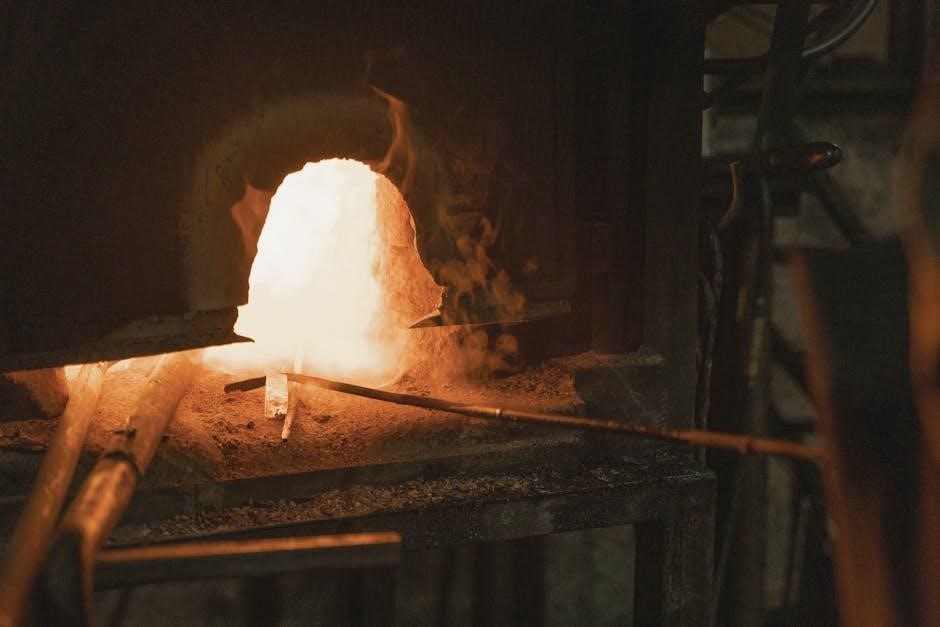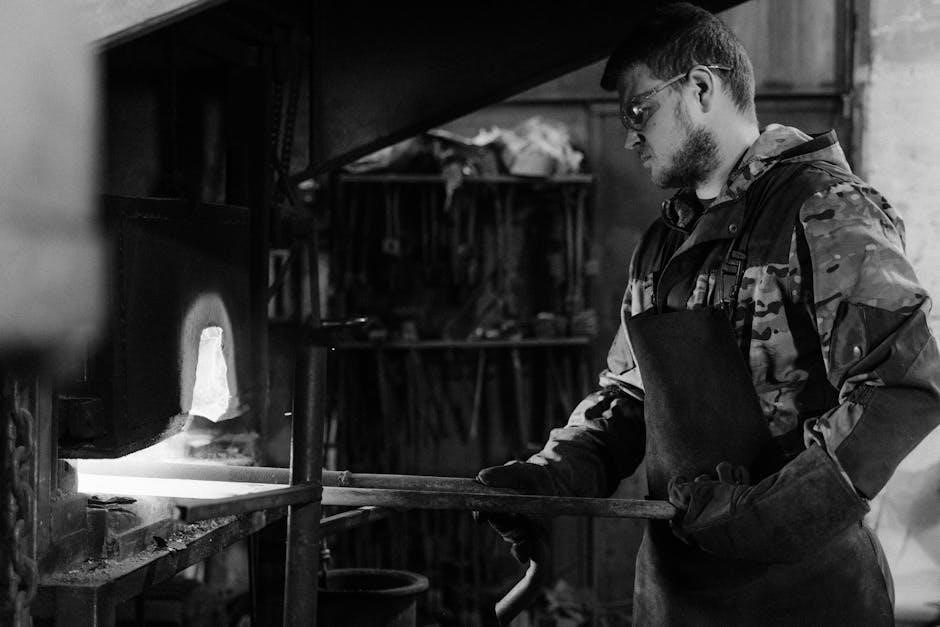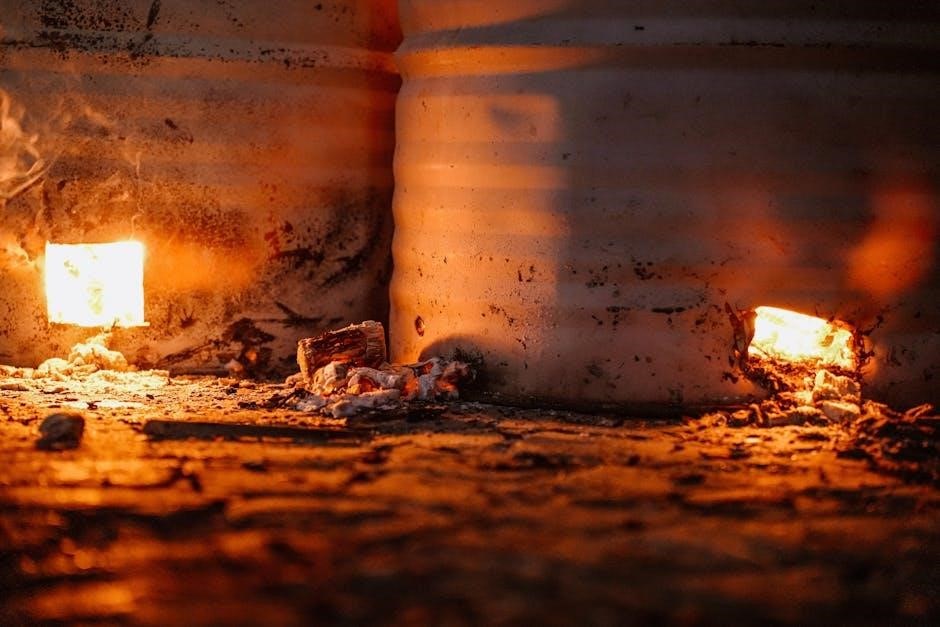Welcome to the Goodman Furnace Manual. This guide provides essential information for installing, operating, and maintaining your furnace. Ensure safety, efficiency, and proper usage.
1.1 Overview of the Goodman Furnace
The Goodman Furnace is a high-efficiency heating solution designed for reliability and energy savings; Known for its durable construction and advanced features, it offers consistent warmth during cold seasons. Available in various models, including single-stage and two-stage options, Goodman Furnaces cater to different home sizes and heating needs. With AFUE ratings up to 98%, these furnaces provide exceptional energy efficiency, reducing utility bills. Their compact design and quiet operation make them ideal for residential use. Equipped with self-diagnostic controls, Goodman Furnaces ensure optimal performance and safety. This overview highlights the key benefits and features, preparing users for detailed installation and maintenance guidance in subsequent sections.
1.2 Importance of the Manual
This manual is essential for safe and efficient operation of your Goodman Furnace. It provides detailed instructions for installation, maintenance, and troubleshooting, ensuring optimal performance. By following the guidelines, users can prevent potential hazards and extend the furnace’s lifespan. The manual also includes critical safety information, such as gas shutoff procedures and venting requirements. For technicians, it offers technical specifications and diagnostic codes to address common issues. Whether you’re a homeowner or an HVAC professional, this manual is a comprehensive resource to maximize efficiency, safety, and system reliability. Always refer to it before performing any installation, adjustment, or repair to avoid costly mistakes and ensure compliance with manufacturer recommendations.

Installation Guidelines

Proper installation ensures safety, efficiency, and optimal performance. Follow manufacturer instructions, conduct pre-installation checks, and ensure compliance with local codes and regulations for a successful setup.
2.1 Pre-Installation Checks
Before installing your Goodman furnace, ensure the gas supply is turned off at the manual shutoff valve. Verify electrical connections are compatible and secure. Check for proper venting and combustion air intake to prevent obstructions. Ensure the installation area is clear of debris and flammable materials. Review local building codes and manufacturer specifications to confirm compliance. Inspect the furnace for any damage or defects prior to installation. Proper preparation ensures a safe and efficient setup, minimizing potential issues during operation. Always follow the manufacturer’s guidelines for a successful installation process.
2.2 Step-by-Step Installation Process
Begin by positioning the furnace in a well-ventilated area, ensuring compliance with local building codes. Connect the gas line to the furnace, securing it tightly to avoid leaks. Install the venting system according to the manufacturer’s specifications, ensuring proper combustion air intake. Connect the electrical wiring, referring to the wiring diagram in the manual. Mount the thermostat and connect it to the furnace. Test the system by turning on the power and gas supply, checking for proper ignition and airflow. Ensure all connections are secure and verify that the furnace operates quietly and efficiently. Follow the manual’s instructions precisely for a safe and successful installation.
2.3 Post-Installation Testing
After installation, turn off the gas supply and ensure all electrical connections are secure. Check for gas leaks using a soap solution or leak detector. Verify proper venting by ensuring all vents are clear and functioning correctly. Test the electrical system by turning on the power and checking for proper ignition. Ensure the thermostat is calibrated and functioning accurately. Run the furnace through a full cycle to confirm smooth operation and consistent heating. Check for any unusual noises or vibrations. Finally, review the installation with the homeowner, explaining operation and safety features. Ensure all safety precautions are understood and followed.

Operation and Maintenance

This section covers daily operation, adjusting settings, and routine maintenance. Perform daily checks, adjust thermostat settings as needed, and schedule regular maintenance to ensure optimal performance and safety.
3.1 Daily Operation Instructions
Ensure the furnace is turned on and set to the desired temperature using the thermostat. Check the gas valve is fully open and verify proper venting. Monitor the furnace for unusual noises or odors. Perform daily visual inspections of vents and filters, ensuring they are clean and unobstructed. Refer to the manual for specific operating modes and settings. Always follow safety guidelines, such as turning off the furnace before servicing. Regularly check the thermostat batteries and ensure it is functioning correctly. Maintain a safe distance from the furnace during operation and keep the area clear of flammable materials. Follow these steps to ensure efficient and safe daily operation.
3.2 Adjusting Furnace Settings
Adjusting your Goodman furnace settings ensures optimal performance and comfort. Use the thermostat to set desired temperatures, with options for heat, cool, or fan-only modes. For Goodman models like the GTST, navigate the control panel to modify settings such as heat cycles or fan speed. Refer to the manual for specific instructions on accessing advanced features. Ensure temperature adjustments align with seasonal needs, and consider programmable settings for energy efficiency; Always turn off the furnace before making electrical adjustments. If unsure, consult the manual or contact a professional. Proper setting adjustments enhance efficiency, comfort, and system longevity.
3.3 Routine Maintenance Tasks
Regular maintenance is crucial for optimal furnace performance. Clean or replace air filters monthly to ensure proper airflow and efficiency. Inspect vents and ducts for blockages or leaks, ensuring they are clear. Check the thermostat calibration and adjust if necessary. Lubricate moving parts annually, and inspect the heat exchanger for damage. Turn off power before performing any maintenance. Clean the burner compartment and blower assembly as needed. Ensure the gas valve is functioning correctly and verify venting systems are secure. Refer to the manual for specific instructions. Schedule professional inspections annually for comprehensive checks. Proper maintenance enhances safety, efficiency, and system longevity.
Technical Specifications
This section outlines the technical specifications of Goodman furnaces, including AFUE ratings, energy efficiency, and compatibility with other HVAC systems, ensuring optimal performance and integration.
4.1 Key Features of Goodman Furnaces
Goodman furnaces are known for their high-efficiency performance, durability, and innovative technology. They feature advanced heat exchangers, multi-stage burners, and quiet operation. Many models offer high AFUE ratings, ensuring energy savings. The furnaces are equipped with self-diagnostic controls for easy troubleshooting and maintenance. Additionally, they are compatible with smart thermostats, allowing for precise temperature control and enhanced comfort. Goodman furnaces also include safety features like automatic shutoff and venting safeguards. Their compact designs make them suitable for various installation spaces. With a focus on reliability and efficiency, Goodman furnaces provide long-lasting heating solutions for residential and commercial applications.
4.2 AFUE Ratings and Energy Efficiency
Goodman furnaces are recognized for their high Annual Fuel Utilization Efficiency (AFUE) ratings, which measure how efficiently they convert fuel into heat. With AFUE ratings ranging from 80% to over 98%, these furnaces offer significant energy savings. Higher AFUE models are designed to minimize energy waste, reducing utility bills and environmental impact. Goodman furnaces with high AFUE ratings are ideal for homeowners seeking eco-friendly and cost-effective heating solutions; These energy-efficient systems are also eligible for rebates and incentives in some regions. By prioritizing energy efficiency, Goodman furnaces provide reliable performance while promoting sustainability.
4.3 Compatibility with Other HVAC Systems
Goodman furnaces are designed to integrate seamlessly with other HVAC components, ensuring a comprehensive heating and cooling system. They are compatible with a wide range of thermostats, air conditioners, and air handlers, allowing for tailored climate control. Additionally, Goodman furnaces work well with smart home devices, enhancing convenience and energy management. Compatibility with R-32 systems further highlights their adaptability to modern HVAC requirements. Proper installation ensures optimal performance when paired with other system components. This versatility makes Goodman furnaces a reliable choice for homeowners seeking a cohesive and efficient HVAC setup.

Safety Precautions
Always turn off power and gas before servicing. Ensure proper ventilation and follow installation instructions. Avoid improper adjustments to prevent hazards. Adhere to safety guidelines for optimal operation.
5.1 Gas Shutoff Procedures

To ensure safety, locate the manual gas shutoff valve, typically found near the furnace or along the gas supply line. Turn off the furnace and allow it to cool. Move the valve clockwise to shut off gas flow. Verify the valve is fully closed and check for leaks using a soap solution. Never attempt to shut off gas during an emergency; instead, evacuate and contact professionals. Always follow manufacturer instructions and local regulations. Regularly inspect the valve for proper function. If unsure, consult a certified technician to avoid hazards. Proper gas shutoff is critical for maintenance and emergency situations.
5.2 Venting and Combustion Air Requirements
Proper venting and combustion air intake are critical for safe and efficient furnace operation. Ensure the venting system is installed according to local codes and manufacturer guidelines. The furnace requires adequate combustion air to burn fuel efficiently and prevent hazardous fumes. Check for any obstructions in vents or air intake openings. Use approved venting materials and ensure all connections are secure. Refer to the installation manual for specific venting configurations. Proper ventilation prevents carbon monoxide buildup and ensures optimal performance. Always follow ETL certification standards for venting systems. Improper installation can lead to safety hazards and reduced furnace efficiency.
5.3 Electrical Safety Measures
Ensure all electrical connections are made by a qualified technician to avoid hazards. Always disconnect power before servicing the furnace. Use properly rated wiring and circuits as specified in the manual. Keep electrical components clean and dry to prevent short circuits. Never modify or bypass safety devices like circuit breakers or fuses. Regularly inspect electrical connections for wear or damage. Grounding must be done correctly to prevent electrical shocks. Follow local electrical codes and manufacturer guidelines for installation. Proper electrical setup ensures safe and efficient furnace operation. Improper wiring can lead to safety risks and equipment damage. Always refer to the manual for specific electrical requirements.
Troubleshooting and Repair
This section helps identify common furnace issues, understand diagnostic codes, and provides step-by-step solutions. It also guides when to call a professional for assistance.
6.1 Common Issues and Solutions
Common issues with Goodman furnaces include error codes, uneven heating, and ignition problems. Solutions often involve checking gas supply, ensuring proper venting, and cleaning filters. For error codes, refer to the diagnostic chart in the manual. Ignition issues may require resetting the furnace or replacing the igniter. Uneven heating can be resolved by adjusting ductwork or ensuring proper insulation. Always turn off the gas and power before performing repairs. If issues persist, contact a certified technician. Regular maintenance, like cleaning filters and inspecting vents, can prevent many problems. Consult the manual for specific troubleshooting steps tailored to your furnace model.
6.2 Understanding Diagnostic Codes
Goodman furnaces use diagnostic codes to identify issues. These codes, such as “E1” or “E2,” flash on the LED indicator or display on compatible thermostats. Refer to the manual for code meanings, as they vary by model. Common codes indicate problems like ignition failures, pressure switch issues, or faulty sensors. Understanding these codes helps in troubleshooting and resolving issues quickly. For example, an “E1” might indicate a flame sense failure, while “E2” could signal a high temperature limit. Always consult the manual or contact a professional if unsure. Regular maintenance can prevent many code-related issues, ensuring optimal furnace performance and safety.
6.3 When to Call a Professional
If you encounter complex issues or are unsure about repairs, it’s crucial to call a licensed HVAC professional. Diagnostic codes like “E1” or “E2” may indicate serious problems requiring specialized tools. Gas leaks, electrical issues, or venting problems are safety hazards that demand professional attention. Additionally, if your furnace’s self-diagnosing system flags critical errors, don’t attempt DIY fixes. Professionals ensure repairs are done safely and correctly, preserving your warranty. They also handle system compatibility and advanced troubleshooting. For your safety and the furnace’s efficiency, always consult a qualified technician for major issues or unclear diagnostic codes. This ensures long-term reliability and performance.

Warranty and Support
Goodman furnaces come with comprehensive warranties ensuring durability and performance. Register your product to activate warranty benefits and access dedicated support for assistance.
7.1 Warranty Registration Process
Registering your Goodman furnace warranty ensures protection and support. Visit the official Goodman website and navigate to the warranty section. Provide required details like model number, serial number, installation date, and contact information. Submit the form online to activate your warranty. Keep a copy of your registration confirmation for future reference. Proper registration is essential to enjoy warranty benefits and extended support. Ensure all information is accurate to avoid delays. This process guarantees you receive timely assistance and maintains your furnace’s performance. Registration is a straightforward step to secure your investment and access dedicated customer service.

7.2 Terms and Conditions
The Goodman furnace warranty is subject to specific terms and conditions. Proper installation by a certified technician is mandatory to validate the warranty. Any misuse or unauthorized modifications void coverage. Registration must be completed within the specified timeframe. The warranty covers parts and labor for defects in materials and workmanship under normal use. Damage from negligence, improper maintenance, or natural disasters is excluded. Goodman reserves the right to modify terms without notice. Users must comply with all safety guidelines and local regulations. Failure to adhere to these conditions may result in warranty termination. Review the full terms on the Goodman website for detailed information.
7.3 Contact Information for Support
For assistance with your Goodman furnace, contact their customer support team. Call their toll-free number at 1-800-654-5981 for technical inquiries or service requests. Email support is available at support@goodmanmfg.com. Visit their official website at www.goodmanmfg.com for resources, manuals, and FAQs. Live chat is also accessible on their site for immediate help. For warranty-related questions, reach out to their dedicated warranty department at warranty@goodmanmfg.com or 1-800-654-5982. Ensure to have your furnace model number, such as AVPTC-31374, ready for faster assistance. Goodman support is available 24/7 to address your concerns and provide solutions. Visit their website for additional contact options and regional support details.
The Goodman Furnace Manual is a comprehensive guide designed to help users understand and manage their furnace effectively. From installation and operation to maintenance and troubleshooting, this manual provides detailed insights to ensure optimal performance. By following the guidelines, users can enhance safety, efficiency, and overall comfort. Always refer to this manual for any furnace-related queries or adjustments. For further assistance, contact Goodman’s customer support using the provided contact information. Proper usage and regular maintenance will extend the lifespan of your furnace and ensure reliable service. Thank you for choosing Goodman for your heating needs.

